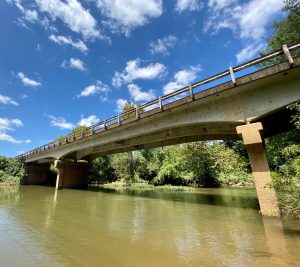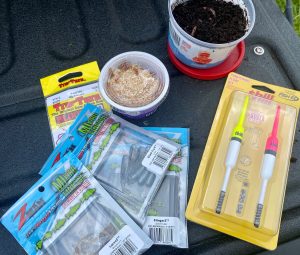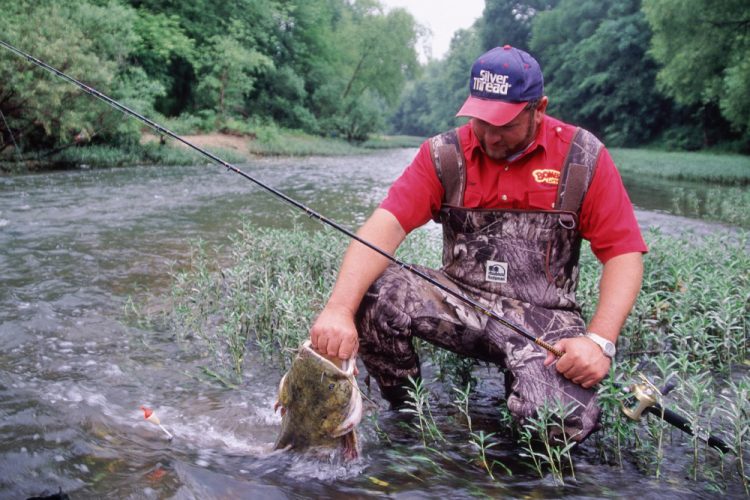Small rivers often have cleaner water, gravel bottoms and easy access
areas for anglers who want to wade or launch a canoe or kayak.
Small River Adventures
By Alan Clemons
Small rivers throughout the country can offer great fun for catfish anglers. But you have to make a few changes to your approach to be successful.
Small rivers are wonderful places to explore, enjoy and fish whether you’re a youngster out with buddies or a wily veteran on a peaceful getaway. These waterways quite often are overlooked, or not even considered, by many anglers, despite the great opportunities throughout the country.
Along with the fun of catching fish, it’s always great to learn about new tackle setups and waters. You may not be able to use a sonar unit on a small river and, for a change, would have to go Old School. Getting back to your roots can be a good thing. If you had a nice “crick” nearby as a kid, you know the joys of flipping rocks to see what’s underneath, making homemade fishing rods, taking real rods and bait later on, and learning about yourself, the waterway and nature.

What is a small river? There is no clear-cut definition. The biggest rivers we know of are like the big ol’ corn-fed offensive linemen of the old Big 10 or Big 12, when a Wisconsin or Nebraska trench looked like small trucks with helmets. Smaller rivers would be akin to lithe, wiry wide receivers or defensive backs, quiet and productive with sudden, occasional flourishes of panache.
Federal and state agencies don’t have definitions for small rivers. But we know them when we see them, right? The winding, beautiful Buffalo rivers (two!) in Arkansas and west Tennessee. The Elk in central Tennessee and north Alabama. The Boone and Big Sioux in Iowa, Canadian in Oklahoma, Susquehanna in New York and Pennsylvania. Plus, thousands of others throughout the country.
These tributaries feed other rivers that feed others and others. On a map, they look like an elder’s varicose veins. Ultimately, these small rivers flow into a major river we recognize immediately: the Ohio, Mississippi, Tennessee, Coosa, Illinois, Arkansas, Chesapeake, Chattahoochee and others.
You likely will find channel cats in smaller rivers, unless you’re closer to the main river the tributary feeds. Then you may encounter blues and flatheads, which prefer bigger waters. You may catch one of those in a smaller river, nevertheless. If you’re fishing a tributary feeding directly into the Tennessee or Arkansas, for example, you may encounter a variety. On a smaller waterway in Indiana or Minnesota, the channel cat might be your huckleberry.
Riffles, Runs, Pools
Smaller rivers often have the combination of riffles, runs and pools. Trout anglers look for these. Catfish anglers should, too.
Apply your big water knowledge to the smaller rivers in this situation. In a boat, canoe or kayak, have an anchor and do the dance: anchor above a deeper pool, hole or target zone, cast, wait. If you’re wading, making smart casts and being patient is critical.
Pools likely will be Mr. Whiskers’ home base. They provide a getaway, cooler temperatures, the ability to explore forage possibilities and an escape downriver if necessary. Just like with large waters, the addition of big rocks, a stump, log, snag or other cover may increase the chances of one or more fish being there, depending on the depth and size of the pool. A sizeable logjam, of course, could mean even more or larger fish enjoying the cover.
That’s not to say swift water won’t hold hungry catfish. Where a small river flows two to three feet deep over a hard or gravel bottom, you may encounter good action. Catfish are opportunists and won’t always be hiding on the bottom, in a hole or by a log. Don’t overlook fishing in areas with good current.
Top Targets

Many small rivers will have cut banks. These may be from a channel bend hitting a specific spot with soft or sandy soil, or from carving underneath tree roots. Trees that have fallen due to erosion may leave cut banks or holes. Whatever the case, catfish often will utilize these spots to loaf or for ambush. Don’t overlook them if you’re drifting baits and make pinpoint casts to allow your rig to float past.
Bridge pilings may be super spots, Pilings often are sunken into hard bottom, with silt and logs or other detritus smashed into the upside. If the current is swift, an eddy or deeper spot could be on the backside. Either could hold a catfish lurking in calmer waters waiting on something tasty to drift past. Bridges usually have multiple pilings, too.
Logs along the bank, jams in bends, old rock or gravel roadbeds on the bottom (usually near existing roads), train trestle supports, bridges, culvert washouts and riprap all are possible targets for small river cats.
Downsize Everything
With smaller rivers you’ll want to downsize everything if the fish in the river aren’t big. You don’t want to take a knife to a gun fight.
If the river has big blues or flatheads, or maybe channel cats that make you say, “Whoa!”, then rig up accordingly. Just like on big water, your rigs should be in tune with your realistic expectations.
If you’re keen on circle hooks, use them. They’re great and work well. In smaller waters, a straight-shank worm hook like bass anglers use also is a good option. Personally, I like the Tru-Turn hooks with the shank bend that helps secure it when I set the hook. These are for worms, livers and chunks. If you’re using stinkbait, your favorite treble in a smaller size should work.
For deeper holes, have some 1/2- to 3/4-ounce egg sinkers in your tacklebox along with split shot of different sizes. Use the one that works best with the current and your setup. If you’re drifting under a float, the split shot rig should be optimal. If you’re bouncing on the bottom or using a three-way or Carolina rig, perhaps opt for the egg sinkers. Heavy split shot might work on the bottom, too, if the current isn’t too swift.
For line size, again consider the size of the fish. You may be able to get away with 8- or 10-pound test in open water. If the smaller river has snags, stumps or other breakaway potential, maybe increase to 14- or 17-pound test. Spinning rods and reels can help with more accurate casts. Closed-faced spincast reels also are great for small rivers.
The old standby of chicken livers and hearts is an easy, top option, as are redworms or nightcrawlers. Consider your waters and the forage base. Catfish in small rivers may feast on cicadas, mayflies, smaller fish such as shad or suckers, crayfish, bluegills and small sunfish. Check state regulations for using live bait such as sunfish, suckers or crayfish. Unlike on big waters, you don’t need a giant shad fillet, head or gut sack. A small chunk of fresh shad will work. Cut the head into two or three pieces, smash them to get everything flowing and use one chunk.
In the summer, catalpa worms are great if you can find them. They’re tough, stay on a hook and catfish love them. Nightcrawlers, too. Thread them on the hook with a little bit hanging. You’ll figure out what works best, and how much, before long.



